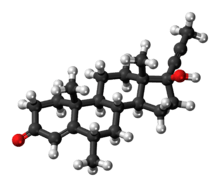Dimethisterone
 | |
 | |
| Clinical data | |
|---|---|
| Routes of administration | Oral |
| Identifiers | |
| |
| Synonyms | Dimethindrone |
| CAS Number | 79-64-1 |
| PubChem (CID) | 6607 |
| ChemSpider | 6357 |
| UNII | OIC9M646C5 |
| Chemical and physical data | |
| Formula | C23H32O2 |
| Molar mass | 340.50 g/mol |
| 3D model (Jmol) | Interactive image |
| |
| |
Dimethisterone (INN, USAN, BAN) (brand names Lutagan, Secrosteron), also known as 6α,21-dimethylethisterone, is a steroidal progestin related to ethisterone (17α-ethinyltestosterone).[1][2][3][4] It was developed by the British pharmaceutical company British Drug Houses (which subsequently merged with Merck KGaA) and was first reported in the medical literature in 1959,[1][5] with introduction for medical use as Secrosteron following in the same year.[6][7]
Dimethisterone was derived from modification of ethisterone via introduction of methyl groups at the C6α and C21 positions.[8][6] Relative to ethisterone, it is 12 times as potent orally as a progestogen in animals (Clauberg test),[5][6] and, unlike ethisterone,[9] is a pure progestogen with no androgenic (or estrogenic) activity in animals even at very high doses (although some weak antimineralocorticoid activity was observed at high doses in animals).[5][10][11] However, in spite of its improved potency over ethisterone, it is a weak progestogen relative to most other progestins,[3] in fact one of the weakest known.[2]
Dimethisterone was introduced in the United States as an oral contraceptive in combination with high doses of ethinyl estradiol under the brand name Oracon (25 mg dimethisterone, 100 μg ethinyl estradiol) in 1965.[12] Due to the fact that it contains a weak progestogen in combination with a large dose of a potent estrogen, this preparation was eventually found to be associated with a substantially increased risk of endometrial cancer in women, and is now no longer marketed.[13]
The improved potency of dimethisterone due to 6α-methylation reportedly served as the basis for the synthesis of medroxyprogesterone acetate.[6] Whereas hydroxyprogesterone acetate (the 6α-demethylated analogue of medroxyprogesterone acetate) is around twice as potent as ethisterone orally,[14] medroxyprogesterone acetate shows 10 to 25 times the potency of ethisterone.[6]
See also
References
- 1 2 J. Elks (14 November 2014). The Dictionary of Drugs: Chemical Data: Chemical Data, Structures and Bibliographies. Springer. pp. 430–. ISBN 978-1-4757-2085-3.
- 1 2 Rodolfo Paoletti; N. Pasetto; J.L. Ambrus (6 December 2012). The Menopause and Postmenopause: The Proceedings of an International Symposium held in Rome, June 1979. Springer Science & Business Media. pp. 374–. ISBN 978-94-011-7230-1.
- 1 2 Earl A. Surwit; David Alberts (6 December 2012). Endometrial Cancer. Springer Science & Business Media. pp. 11–. ISBN 978-1-4613-0867-6.
- ↑ Richard Patterson (21 December 2012). Drugs in Litigation: Damage Awards Involving Prescription and Nonprescription Drugs. LexisNexis. pp. 483–484. ISBN 978-0-327-18698-4.
- 1 2 3 DAVID A, FELLOWES KP, MILLSON DR (1959). "Some biological properties of dimethisterone "secrosteron" a new orally active progestational agent". The Journal of Pharmacy and Pharmacology. 11: 491–5. PMID 13814263.
- 1 2 3 4 5 Norman Applezweig (1962). Steroid Drugs. Blakiston Division, McGraw-Hill. pp. 101–102.
At The British Drug Houses, Ltd., V. Petrow and his group decided that substitution at the 6 position should help to strengthen the progesterone molecule. They prepared a series of 6α and 6β derivatives and, finding enhancement with 6α-methyl, proceeded to modify ethisterone and finally produced 6α,21-dimethylethisterone, which proved to have twelve times the oral activity of ethisterone. This latter product is marketed by British Drug Houses under the name of Secrosteron.
- ↑ Medical Proceedings: A South African Journal for the Advancement of Medical Science. Juta and Company. 1959. p. 269.
Secrosteron a new oral progestational substance British Drug Houses (South Africa) (Pty.) Ltd., announce the introduction of Secrosteron, a new fundamental discovery from the Research Laboratories of the British Drug Houses Ltd., London.
- ↑ Thomas L. Lemke; David A. Williams (2008). Foye's Principles of Medicinal Chemistry. Lippincott Williams & Wilkins. pp. 1316–. ISBN 978-0-7817-6879-5.
- ↑ Richard M. Eglen; Mont R. Juchau; Gillian Edwards; Arthur H. Weston; Helen Wise; M. D. Murray; D. Craig Brater; Olivier Valdenaire; Philippe Vernier; Annemarie Polak (6 December 2012). Progress in Drug Research: Fortschritte der Arzneimittelforschung / Progrès des recherches pharmaceutiques. Birkhäuser. pp. 72–. ISBN 978-3-0348-8863-9.
- ↑ Vademecum International. J. Morgan Jones Publications. 1959. p. 90.
Secrosteron (dimethisterone) is an orally active purely progestational agent twelve times as potent as ethisterone.
- ↑ JUCKER (8 March 2013). Fortschritte der Arzneimittelforschung / Progress in Drug Research / Progrès des recherches pharmaceutiques. Birkhäuser. pp. 166–. ISBN 978-3-0348-7053-5.
- ↑ William Andrew Publishing (22 October 2013). Pharmaceutical Manufacturing Encyclopedia, 3rd Edition. Elsevier. pp. 1331–. ISBN 978-0-8155-1856-3.
- ↑ Richard R. Barakat; Maurie Markman; Marcus Randall (2009). Principles and Practice of Gynecologic Oncology. Lippincott Williams & Wilkins. pp. 5–. ISBN 978-0-7817-7845-9.
Studies have shown that women who used Oracon, a sequential preparation that employed dimethisterone (weak progestogen) with a large dose of a potent estrogen (ethinyl estradiol), had substantially elevated risks of uterine cancer (6,21). The risk associated with the use of other sequential oral contraceptives remains unclear, mainly because these drugs are no longer marketed.
- ↑ DAVIS ME, WIED GL (1957). "17-alpha-HYDROXYPROGESTERONE acetate; an effective progestational substance on oral administration". The Journal of Clinical Endocrinology and Metabolism. 17 (10): 1237–44. doi:10.1210/jcem-17-10-1237. PMID 13475464.
It is the purpose of this paper to introduce and describe a new steroid for oral administration, 17-a-hydroxyprogesterone acetate*, and to compare it with the most widely used oral substance with progestational properties, 20,21-anhydro-17-/3-hydroxyprogesterone. * Prodox, Upjohn Co., Kalamazoo, Michigan [...] It was found that 17-a-hydroxyprogesterone acetate has a progestational activity which is at least twice that of anhydrohydroxyprogesterone.